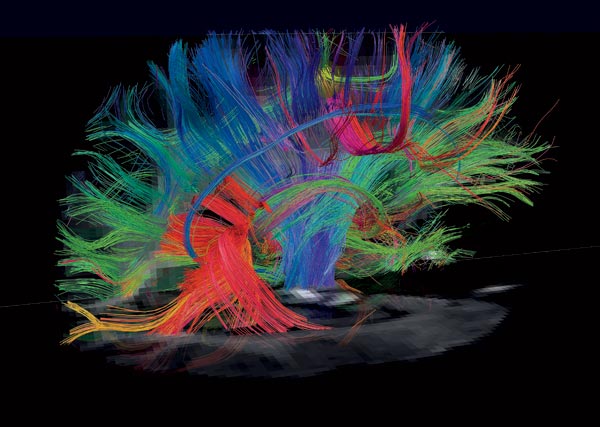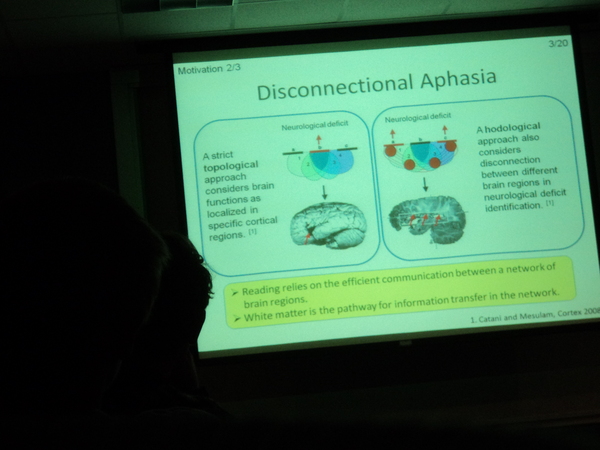Microspheres and DTI: What Am I Doing Here?
This afternoon, I got a chance to see two presentations by Master’s candidates in the Biomedical Engineering department. Surrounded by rabidly hungry grad students (it was actually really funny to see them race for the free pizza), I was first treated to an intellectually stimulating presentation on smart microspheres developed to release drugs in a stimuli-responsive pattern; an inject-able kind of gel that can release medicine based on pH or other environmental factors to prevent toxicity via quick-release. (The presentation was technically titled “Smart microspheres for stimuli responsive drug delivery,” by Rucha Joshi). Despite the fact that I am 1) not a BME, 2) not a grad student, and 3) not that smart, the ideas were presented in a way that I managed to keep up with, and the concept was really cool!

After Rucha presented her research, Quiyun Fan was up to talk about possible correlations between certain brain connections and reading ability in children. Last year in my BME Module (in our Intro to Engineering course), we learned about Diffusion Tensor Imaging, a very new and theoretical kind of brain scanner that, put simply, measures and represents the diffusion of water in brain fibers, which, in an image, shows up as different colors to represent the direction vectors of fluid flow.

If you’re lost, hold on! Fan theorized that the size and strength of certain connective pathways between areas of the brain important to reading would be directly correlated to reading ability in children, and the study (conducted on 8 or 9 children) confirmed this hypothesis. Interestingly, in response to question posed after her presentation, Fan pointed out that people asked to learn to juggle strengthened the connections in their brain relevant to motor skills, hand-eye coordination, and other juggling-essential tasks. In light of this, a child’s best bet of improving reading skills is, you guessed it, reading! All in all, it was really neat (and kind of out of the blue) to see these presentations and get a glimpse at what the grad students all around are doing!

If the abstracts for either project are intriguing to you:
————————————————————————————————————————————–
“Smart microspheres for stimuli responsive drug delivery”
Rucha Joshi
Tunable and sustained drug delivery platforms have great unmet potential to be used for more optimal treatment of human diseases. Such delivery devices avoid bolus delivery and its undesirable systemic effects and toxicity. Controlled release can also overcome issues related to insufficient local concentrations of drug for the required timeframe since a single injection of naked drug can result in rapid degradation and subsequent distribution throughout the body. Microspheres offer one route for sustained and controlled release that have great potential as ideal platforms to deliver drugs in an optimized, sustained pattern. Many hydrolytically biodegradable microspheres have been pursued (i.e., PLGA). The focus of this thesis work has been on utilization of “smart”, stimuli-responsive polymers that release drugs at a rate dictated by the environment rather than hydrolytic degradation mechanisms that act independent of any environmental cues. For example, we have specifically sought applications for delivery to slightly acidic pH (5-7) tissues in cardiac ischemia and chronic diabetic wounds and to tissues laden with cell-damaging reactive oxygen species (in particular hydrogen peroxide) such as in rheumatoid arthritis.
With this idea in mind, we formulated, characterized and studied in vitro release profiles of two novel types of “smart”, stimuli sensitive microspheres. These were pH and temperature-sensitive microspheres made from poly(NIPAAm-co-PAA-co-BA) (NPB microspheres), and Reactive Oxygen Species (ROS)-sensitive microspheres made from poly(propylene) sulfide (PPS microspheres). These “intelligent” microspheres demonstrated sustained release profile of encapsulated drugs when presented with ischemic pH and hydrogen peroxide as stimuli, indicating their potential for spatio-temporally controlled therapeutic delivery to ischemic and inflammatory environments, respectively. NPB microspheres formulated using a water–in–oil-in-water double emulsion method, were pursued specifically as candidates to encapsulate hydrophilic drugs (i.e. proteins). The PPS microspheres, on the other hand, were generated using a modified oil-in-water single emulsion method in order to pursue applications for delivery of more hydrophobic (i.e., small molecule) drugs.
————————————————————————————————————————————-
“Diffusion Tensor Imaging Reveals Correlations between Brain Connectivity and Children’s Reading Abilities”
Qiuyun Fan
Abstract:
Reading is a complex cognitive process of human brain to decode symbols for the intention of constructing or deriving meaning, which relies on the collaboration of different brain regions. The white matter connecting these regions supports the communication between them and thus plays an important role in mediating reading behavior. Diffusion Tensor Imaging (DTI) is a popular noninvasive Magnetic Resonance Imaging (MRI) method to study in-vivo brain white matter. It detects the anisotropy of the water diffusion in the brain, and uses it to estimate the axon orientations and reconstruct white matter fiber tracts. In this work, DTI is used to study the relationship between brain connectivity and children’s reading abilities.